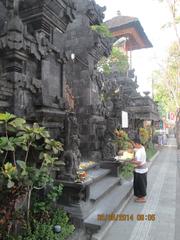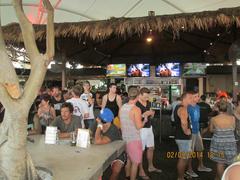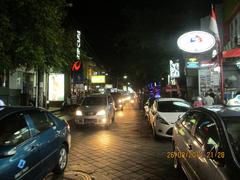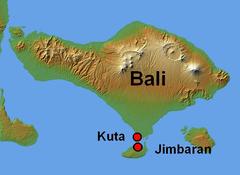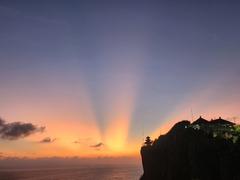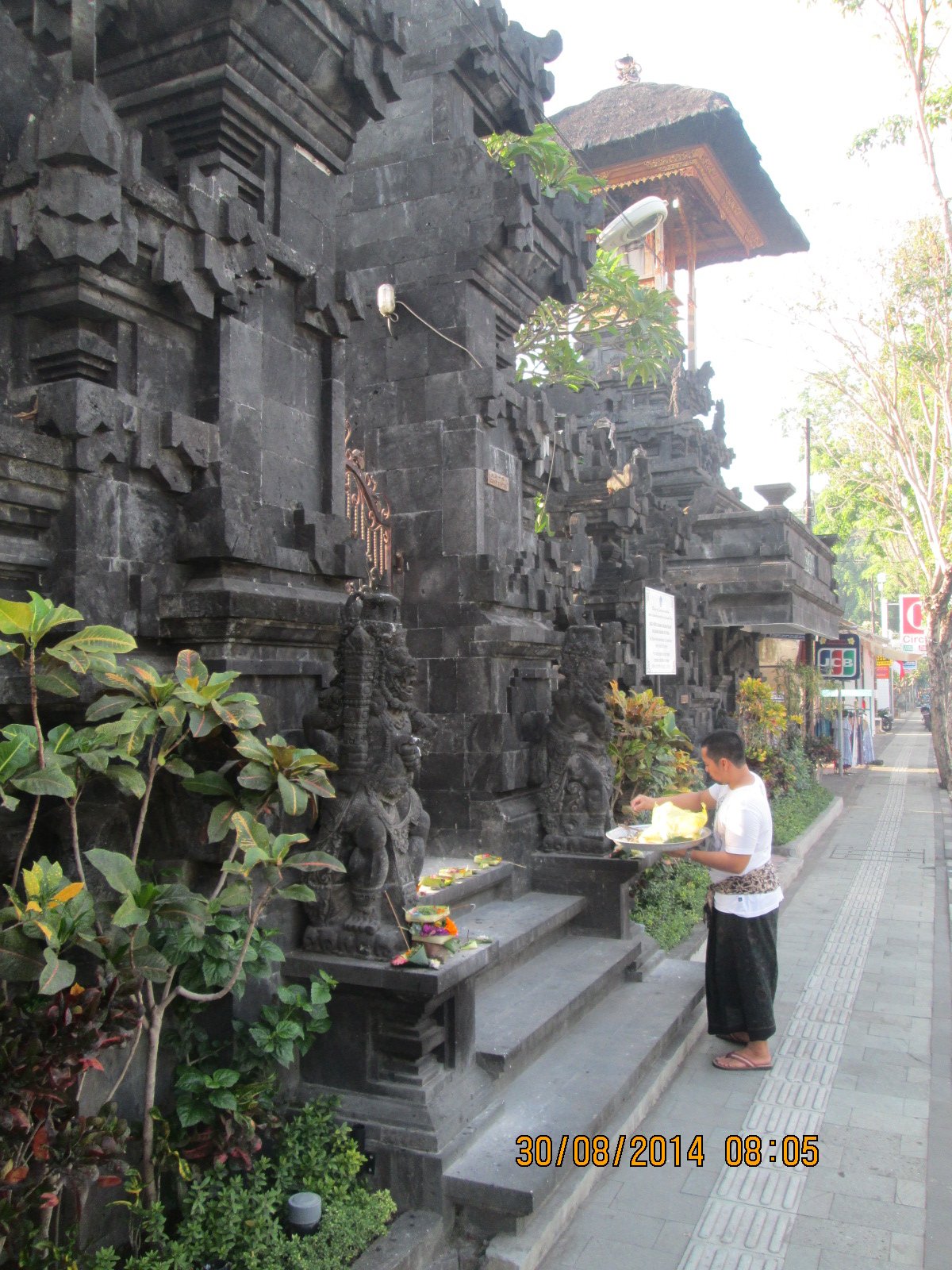
Legian Badung Indonesia: Historical Sites, Visiting Hours, Tickets, and Travel Guide
Date: 15/06/2025
Introduction
Nestled in the heart of Bali’s Badung Regency, Legian is a destination where natural beauty meets rich history and vibrant culture. Renowned for its scenic beaches, lively nightlife, and welcoming atmosphere, Legian also boasts significant historical and spiritual sites rooted in Balinese tradition. The name “Legian,” meaning “sweet” or “pleasant” in Balinese, reflects its enduring charm as a coastal village that has gracefully transitioned into a bustling tourist hub while retaining its cultural authenticity (bali-by-locals.com).
Legian’s heritage is deeply intertwined with the influential Badung Kingdom, which shaped the region’s artistic and religious landscape. Despite waves of colonial influence and rapid modern development, Legian has preserved its spiritual identity through notable temples like Dalem Kahyangan and cultural monuments such as the Legian Monument (ritsumei.ac.jp; balipedia.com). Visitors can immerse themselves in both the natural allure of free-access beaches and the vibrant cultural scene—encompassing festivals, dance performances, and artisan crafts.
This comprehensive guide consolidates essential information on historical sites, visiting hours, ticketing, top attractions, and practical tips for exploring Legian. Whether you’re planning to surf the waves, experience a Balinese festival, or seek tranquility in a temple courtyard, this resource will ensure a rewarding visit. For in-depth travel planning, refer to the Badung Travel Guide and the Official Bali Tourism Website.
Table of Contents
- Introduction
- Historical Background and Significance
- Key Historical Landmarks and Sites
- Visitor Information: Hours, Tickets, and Travel Tips
- Experiences and Popular Activities
- Legian Attractions and Activities
- Practical Tips
- Exploring the Legian Monument
- Exploring Dalem Kahyangan Temple
- FAQs
- Conclusion and Final Travel Advice
- References
Historical Background and Significance
Early History and Pre-Colonial Era
Legian is part of the Badung Regency, an area that thrived under the Badung Kingdom from the 17th to early 20th century. The kingdom championed the arts, traditional architecture, and Balinese Hindu customs, many of which remain central to the region’s identity (bali-by-locals.com). Legian began as a coastal village where livelihoods revolved around fishing, agriculture, and sea-centric rituals. The area’s peaceful reputation is embodied in its name, which means “pleasant.” Residents traditionally followed the Tri Hita Karana philosophy, promoting harmony between humans, nature, and spirituality (ritsumei.ac.jp).
Colonial Encounters and Early Tourism
Dutch contact intensified in the late 19th and early 20th centuries, bringing new administrative systems and economic models. While these changes altered the region, Balinese culture persisted. By the early 20th century, Bali attracted Western anthropologists and artists, setting the stage for future cultural tourism (balipedia.com; bali.com).
Post-Independence and Modern Tourism
Following Indonesia’s independence in 1945, Bali remained relatively isolated until infrastructure projects in the 1960s, such as the Bali Beach Hotel and Ngurah Rai International Airport, made the island more accessible (kabarwisatabali.com). The 1970s ushered in a “backpacker era,” with Legian and Kuta at the heart of an emerging surf scene. This period marked the start of Bali’s transformation into a global tourism magnet (balitouristic.com).
Legian’s Role in Bali’s Tourism Boom
Strategically located between Kuta and Seminyak, Legian became central to Bali’s tourism explosion in the 1980s and 1990s. Hotels, restaurants, and entertainment venues flourished, including the landmark Legian Beach Hotel, established in 1974 and now a symbol of the area’s blend of tradition and hospitality (whatsnewindonesia.com). By the late 1990s, Legian accounted for a significant share of Bali’s hotel accommodations (ritsumei.ac.jp).
Cultural Significance and Preservation
Despite modernization, Legian retains deep cultural roots. Temples, ceremonies, and artistic performances are integral to local life. Melasti purification rituals and other Hindu ceremonies are regularly held on Legian Beach (promobali.com). Sustainable development is guided by the Tri Hita Karana philosophy, and regulations like building height limits protect the traditional landscape (kabarwisatabali.com).
Legian in the Contemporary Era
Today, Legian is a cosmopolitan district offering everything from luxury resorts to local eateries, while heritage sites and hotels continue to preserve its historical character (whatsnewindonesia.com). Legian’s ongoing popularity exemplifies Bali’s efforts to balance economic growth with cultural and environmental stewardship.
Key Historical Landmarks and Sites
- Legian Beach: The heart of Legian’s identity, hosting both leisure activities and religious ceremonies—open daily from sunrise to sunset, free of charge.
- Traditional Temples: Nearby Pura Petitenget and Pura Dalem Legian provide insight into Balinese spiritual heritage (promobali.com).
- Heritage Hotels: The Legian Beach Hotel stands as an example of Balinese design and hospitality, with accommodations available year-round (whatsnewindonesia.com).
Visitor Information: Visiting Hours, Tickets, and Travel Tips
- Beaches: Open daily from 6:00 AM to 6:00 PM, free entrance.
- Temples: Generally open 8:00 AM to 6:00 PM; check locally for special events.
- Tickets: Most beaches are free. Some temples/cultural sites may request a small donation or ticket, payable on-site or via tours.
- Accessibility: Legian is 10 km from Ngurah Rai International Airport. Taxis, rideshare apps, and pedestrian-friendly streets provide easy access.
- Hotel Booking: Book in advance during peak seasons (July–September); many hotels offer flexible online reservations.
- Best Time to Visit: The dry season (April–October) is ideal for outdoor activities.
Experiences and Popular Activities
- Special Events: Join vibrant festivities during Nyepi and Galungan for unique cultural immersion.
- Cultural Tours: Guided tours to historical sites and artisan villages are widely available.
- Photography: Sunsets at Legian Beach and colorful markets offer excellent photo opportunities.
Legian Attractions and Activities
Beaches and Water Activities
Legian Beach
Famed for golden sands and gentle waves, Legian Beach offers a laid-back alternative to nearby Kuta. Open daily, free to enter.
- Surfing: Beginner-friendly waves, surf schools and rentals (IDR 150,000–300,000 per lesson).
- Swimming/Sunbathing: Lifeguards on duty 8 AM–6 PM; sun loungers/umbrellas for rent.
- Beach Sports: Volleyball, soccer, and other games welcome all.
- Water Sports: For motorized activities, visit Tanjung Benoa (30 min drive).
Padma Beach
At Legian’s north end, Padma Beach is quieter and family-friendly—great for yoga, swimming, and sunset strolls.
Nightlife and Entertainment
Bars, Clubs, and Live Music
Jalan Legian features venues like Sky Garden and Bounty Discotheque (open 6 PM–2 AM; free or ticketed events).
- Cultural Nightlife: Experience Balinese dance performances alongside modern nightlife.
Beachfront Dining and Sunset Bars
Enjoy cocktails and local cuisine at places like Azul Beach Club, operating until midnight.
Shopping and Markets
- Street Markets: Jalan Legian and Jalan Melasti teem with handicrafts, clothing, and souvenirs.
- Artisan Goods: Batik, carvings, jewelry, and home décor.
- Modern Shopping: Beachwalk Shopping Center in Kuta (10 AM–10 PM).
Cultural Experiences
- Ceremonies/Festivals: Witness Galungan, Kuningan, and the Omed-Omedan festival (Denpasar).
- Traditional Dance: Local hotels and venues offer Kecak and Legong performances (IDR 100,000–200,000).
- Art Galleries/Workshops: Join painting, batik, or woodcarving classes.
Wellness and Spas
- Spa Treatments: Options range from budget to luxury (starting IDR 150,000).
- Yoga/Fitness: Sunrise/sunset beach yoga and gym facilities are available.
Culinary Experiences
- Cuisine: From street food to upscale dining, enjoy Balinese classics (nasi goreng, satay, babi guling) and international fare.
- Cooking Classes: Many start with market visits and hands-on preparation.
Family-Friendly Activities
- Waterbom Bali: Premier water park in Kuta (open 9 AM–6 PM; IDR 500,000 adults, IDR 400,000 children).
- Animal Encounters: Bali Safari & Marine Park, Ubud Monkey Forest.
Day Trips and Excursions
- Tanah Lot Temple: Iconic seaside temple (7 AM–7 PM; IDR 60,000).
- Garuda Wisnu Kencana Cultural Park: Statue, performances, and panoramic views.
- Seminyak/Canggu: Trendy shopping and beach clubs.
- Tegalalang Rice Terraces: Scenic rice fields and traditional irrigation.
Practical Tips
- Getting Around: Legian is walkable; use Gojek/Grab or rent scooters (international license required).
- Weather: June is ideal, with warm temperatures (~28°C).
- Safety: Exercise caution with valuables and stray animals; travel insurance is recommended.
- Temple Etiquette: Dress modestly; sarongs and sashes are often available for visitors.
Exploring the Legian Monument
History and Significance
The Legian Monument commemorates the community’s resilience and cultural identity, featuring traditional Balinese architecture and intricate carvings. It is a focal point for ceremonies and festivals, symbolizing Legian’s enduring heritage.
Visitor Information
- Opening Hours: 7:00 AM–7:00 PM daily.
- Admission: Free; donations welcomed.
- Guided Tours: Available via local operators and hotels.
Getting There
- From Airport: 6 km (20 min) by taxi or ride-hailing app.
- Within Legian: Easily reached by foot, scooter, or taxi.
Nearby Attractions
- Legian Beach
- Jalan Legian shopping/dining
- Pura Petitenget Temple
Events & Photography
Attend cultural events during Nyepi and Galungan. For photos, visit at sunrise or sunset for the best light—always respect local guidelines during ceremonies.
Tips
- Dress modestly, especially during festivals.
- Stay hydrated and use sun protection.
- Combine visits with nearby cultural sites for a full experience.
Exploring Dalem Kahyangan Temple
History and Significance
Dalem Kahyangan Temple is a revered Balinese Hindu temple, associated with deities of death and the afterlife. Its ornate stone carvings and ceremonies offer deep insight into local spirituality.
Visitor Information
- Location: Legian, Bali
- Hours: 8:00 AM–6:00 PM daily
- Entrance Fee: ~15,000 IDR
- Guided Tours: Arranged via hotels or local operators
Dress Code & Etiquette
Wear a sarong and sash (available for rent or purchase); shoulders and knees must be covered. Remain quiet and do not photograph restricted areas or disrupt ceremonies.
Getting There
- 7 km from Ngurah Rai International Airport (20–30 min by taxi, ride-share, or hotel shuttle).
Nearby Attractions
- Legian Beach
- Merta Nadi Art Market
- Local cafés and restaurants
Tips
- Visit in the dry season (April–October).
- Combine with beach and market visits for a complete day.
FAQs
Q: What are Legian’s beach and temple hours?
A: Beaches: 6:00 AM–6:00 PM. Temples: typically 8:00 AM–6:00 PM.
Q: Are Legian’s beaches free?
A: Yes, public beaches are free to access.
Q: Do I need tickets for cultural sites?
A: Most are free or require a small fee/donation at temples.
Q: How do I book hotels?
A: Online or directly; book early in peak seasons.
Q: Is Legian family-friendly?
A: Yes, with attractions like water parks and animal encounters.
Q: Can I attend dance performances?
A: Yes, ticketed performances are available (IDR 100,000–200,000).
Conclusion and Final Travel Advice
Legian, in Bali’s Badung Regency, stands as a dynamic destination where history, culture, and natural beauty intertwine. From its roots in the Badung Kingdom to its role as a modern tourism hub, Legian remains true to its heritage through temples, monuments, and festivals. Visitors can enjoy free-access beaches, a lively culinary and nightlife scene, and a wealth of activities for all ages.
Understanding Legian’s cultural and historical background deepens your appreciation and enriches your stay. For real-time updates on visiting hours, tickets, and tours, consider downloading the Audiala app and following official tourism channels. Embrace Legian’s vibrant energy and unique traditions for an unforgettable Bali experience (promobali.com; whatsnewindonesia.com).
For further planning resources, see the History of Bali Tourism and curated guides on Bali’s attractions.
References and Further Reading
- Badung Travel Guide
- History of Bali Tourism
- Best Heritage Hotels in Bali
- Balinese Cultural Preservation and Tourism (Ritsumeikan University)
- Legian Monument Visitor Guide
- Dalem Kahyangan Temple Information
- Promobali Badung Regency Cultural Insights
- History of Tourism in Bali (Balipedia)
- Indonesia Travel Entry Requirements
- Bali Travel Guides
